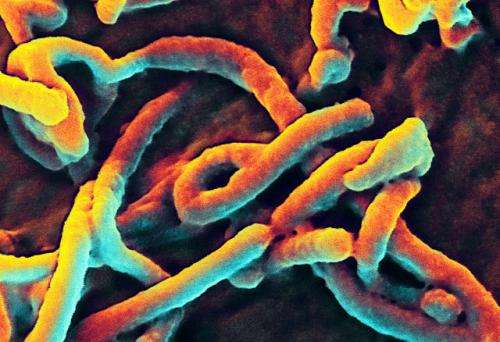A scanning electron micrograph of Ebola virus budding from a cell (African green monkey kidney epithelial cell line). Credit: NIAID
Researchers at SUNY Downstate Medical Center have found an apparent link between human population density and vegetation cover in Africa and the spread of the Ebola virus from animal hosts to humans.
Michael G. Walsh, PhD, MPH, assistant professor of epidemiology and biostatistics in the School of Public Health at SUNY Downstate, notes that there is significant interaction between population density and green vegetation cover in the parts of Africa that have seen outbreaks of Ebola virus disease (EVD).
In contrast, in areas of very low population density, increasing vegetation was associated with a decrease in risk of animal-to-human transmission. The findings were published in the open-access journal PeerJ, on January 20, 2015, in an article titled, "The landscape configuration of zoonotic transmission of Ebola virus disease in West and Central Africa: interaction between population density and vegetation cover."
"These findings cannot be viewed as causal due to the observational nature of the data," says Dr. Walsh, "but they do suggest that the specific landscape configuration of interaction between human populations and forested land may facilitate transmission of the Ebola virus from animals to humans."
He adds, "The reservoir species of the Ebola virus is believed to be fruit bats, with a secondary source being non-human primates. As human populations increase and move into forested areas that are home to these animals, the risk of humans contracting EVD appears to increase, judging from our analysis of EVD outbreaks in Central and West Africa."
More information: The article is available online at: https://peerj.com/articles/735/ .
Journal information: PeerJ
Provided by SUNY Downstate Medical Center























